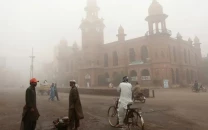Searching for panacea: Pakistan’s vulnerability to climate change highlighted
Experts discuss country’s lack of interest in environment at SDPI seminar.

With inconsistent disaster preparedness and weak institutional response, Pakistan’s challenges related to climate change are worsening with time.
This was stated by former environment minister Malik Amin Aslam at a seminar on climate change and its dimensions held at the Sustainable Development Policy Institute (SDPI)
Aslam, while speaking on climate change and the complexities that exist within, said Pakistan is in the top 10 of countries most affected by climate change, according to German Watch.
The Global Climate Index 2010 ranks Pakistan on number one, with a death toll of 1,891 people due to climate change. Losses per unit sum up to a total of 5.42 per cent of the Gross Domestic Product, reveals the study.
Moreover, challenges from having the region’s highest population density make it a volatile and vulnerable region, said the former minister, adding that with 90 per cent of natural disasters being climate related, the damage costs are going up with a frequency of 60 per cent in the past ten years.
Terming the Prime Minister’s Task Force on Climate Change and Core Committee on Climate Change dysfunctional, Aslam explained that there is a need to revive and streamline both these organisations. Moreover, the provinces needed to build theirs adaptation and mitigation capacity in order to synchronise local institutions with global mechanisms, he said.
“In Pakistan, we do not have a choice. We cannot ignore climate change,” he said.
Ambassador Shafqat Kakakhel, chairperson of SDPI’s board of governors, explained that the majority districts of the country are located in arid and semi-arid zones.
Almost 60 per cent of what is produced in these areas will be confronted with climate change challenges, he said, adding that deforestation and the increasing population are further adding to the challenges.
“If population is growing at a rate of 2 per cent and production remains stagnant, then it is likely that we will be in extremely challenging circumstances soon,” said Kakakhel.
While various policies of the government assign special focus to arid and semi-arid areas of the country, hardly any work is done on the ground as political will remains non-existent and local government structures are weak.
He further added that the coastal areas of Thatta and Badin in Sindh are some of the most vulnerable areas in the country.
Dr Rehana Siddiqui, joint director of Pakistan Institute of Development Economics, said the general public needs to be better educated on issues of climate change. The role of institutions must be identified and their capacity be increased to deal with the present crisis, she added.
Published in The Express Tribune, July 24th, 2014.



















COMMENTS
Comments are moderated and generally will be posted if they are on-topic and not abusive.
For more information, please see our Comments FAQ